[Editor’s Note: Amateur military historian Charles Herrick’s earlier posts in this series corrected 70 years’ worth of miscaptioning of one of Robert Capa’s ten D-Day photographs from Omaha Beach. Via close scrutiny of Capa’s negative 35, Herrick — an ex-combat soldier and avid amateur military historian — demonstrated that what LIFE in its June 19, 1944 issue and most subsequent publications had always described as terrified assault troops sheltering themselves from blistering enemy fire on Easy Red were in fact courageous combat engineers hard at work demolishing Nazi obstacles so that landing craft could approach the beach and offload their troops and materiel.
In this new article, Herrick reviews the military documents, beach topography, and relevant photographs (by Capa and others) to establish, insofar as possible, the exact location and time of Capa’s arrival on Omaha Beach. Part 2 appears below; click here for Part 1. — A. D. C.]
•
Luck of the Draw:
The Seam in the Defenses (continued)
by Charles Herrick
Based on the identification of Capa’s point of arrival at Omaha Beach, my analysis places Capa’s landing at the “Roman ruins” at 0820 hours, coming in with the rear echelon of the regimental command group. (Click to enlarge.)
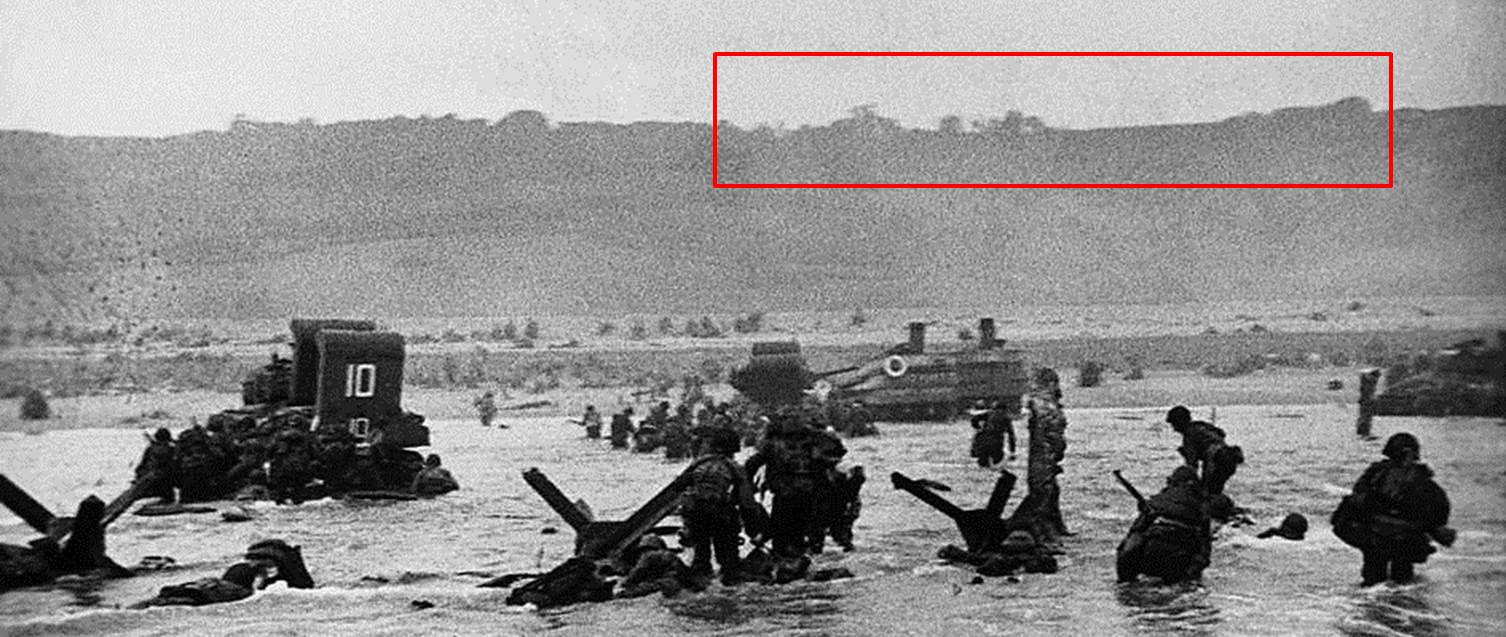
Figure 2. Capa’s negative 32 (detail). Note the configuration of the skyline within the red outline.
The two craft carrying this element — an LCVP and an LCM (Landing Craft, Mechanized) — unloaded their troops without taking enemy fire. It was only as the last man left the LCM that enemy fire resumed. The Headquarters Company commander reported that even then, no one was hit.
Landing in the same LCVP as Capa, the regimental commander walked upright and fully exposed for over an hour with his staff, organizing the assault. When word arrived that Lt. John M. Spalding and Co. G had penetrated the defenses atop the draw behind the ruins, the colonel began shoving units up the same trail. Despite intermittent fire and casualties, the path beside the ruins was the one sure way up to the bluffs.
The freedom of movement at this seam in the defenses began to pay dividends. Spalding’s section attacked Wn 64 from the rear while Co. A attacked it frontally, reducing the strongpoint and making early opening of Exit E-1 possible. Co. G meanwhile had advanced on Colleville, cutting off Wn 62 from resupply and reinforcements, and neutralizing Wn 63, the sector command post. [Note: WN is the abbreviation for widerstandsnest, which translates as “pocket of resistance.” The German military used this term to designate its reinforced-concrete pillboxes for artillery and small-arms weapons and other defensive strongpoints along the Normandy coast. — Ed.]
By 0830 hours, enemy fire on the area of the ruins consisted primarily of intermittent mortar and artillery shelling, and periodic anti-tank fire against larger landing craft. Though disruptive and often destructive, it was nevertheless only marginally effective. LCI(L)-94 — Landing Craft, Infantry (Large) — unloaded its troops without incident, and was only hit as it retracted. It nevertheless went on to make two or three more trips to the beach that day. [Note: LCI(L)-94 arrived from the U.S.S. Samuel Chase with a load of medics and medical supplies. Capa boarded it for his return trip to the U.S.S. Samuel Chase, on which he would return to Weymouth, England. LCI(L)-94 left Omaha Beach with Capa aboard at 0837, according to its log. — Ed.]
By 0840 hours the assistant division commander landed at the ruins and requested that the following infantry waves be accelerated. As a measure of the relatively ineffective fire there, by the end of the day six of the nine follow-on battalions had moved up the bluffs through the expanding gap behind the ruins. What initially had been a small seam in the defenses quickly eroded to become a decisive gap. (Click to enlarge.)
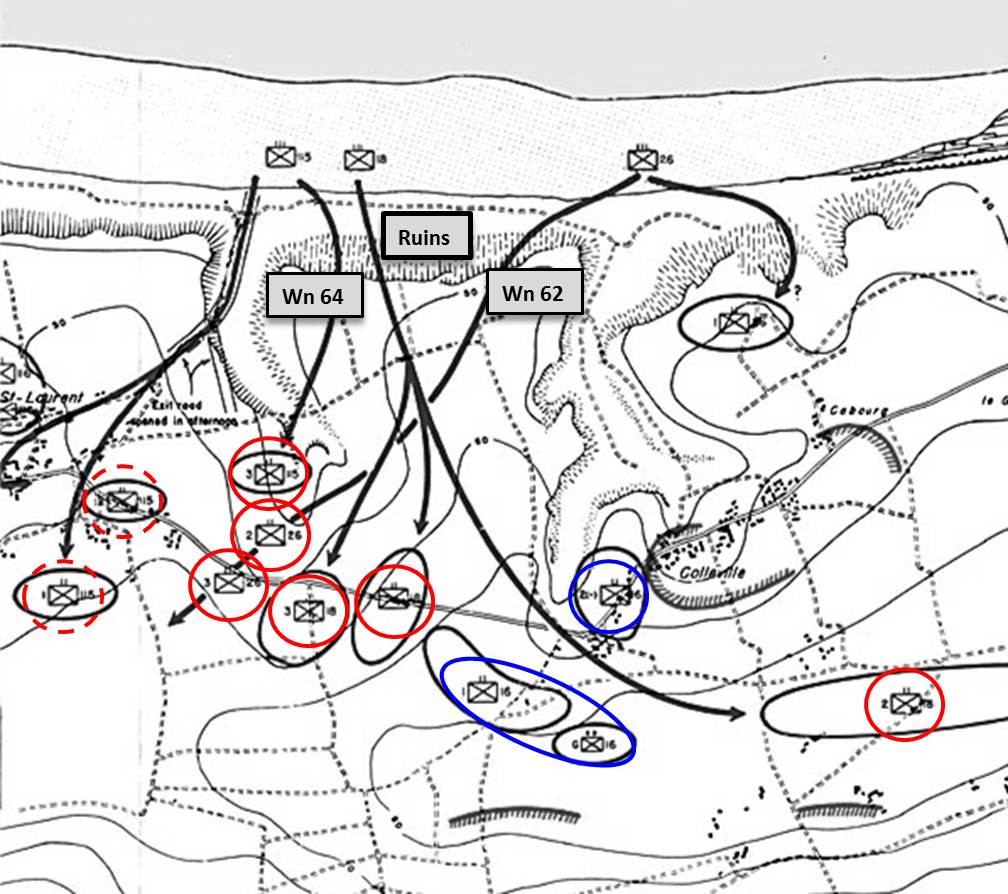
Figure 7. The Torrent through the Seam. Circled in blue are the first two battalions of the 16th RCT that passed inland between Wn 62 and 64. Later on D-Day three follow-on regiments landed, the 18th, 26th and 115th. Of their 9 battalions, six (circled in solid red) followed through the seam behind the ruins. Two more (circled in dashed red) were able to pass through the E-1 draw largely due to Lt. Spalding’s penetration at the seam and attack on WN 64 from the rear.
Although the area of the ruins could be deadly, the decisive results obtained there were largely due to the relatively ineffective enemy fire. That condition existed from the time the very first U.S. troops stepped ashore there. Fire was never able to prevent infantry units from advancing through the seam in the defenses, as evident by the volume of troops passing through there on D-Day.
This judgment is supported by the returns of the regimental medical section. Located behind the ruins at the base of the bluffs, it had collected the day’s casualties from the area, to include the wounded from the 1st and 2nd Battalions’ aid stations. Despite having almost no luck getting wounded evacuated on Navy craft, by 1900 hours it had only 80 casualties under its care. The regiment’s other 440 WIA that day were suffered on parts of the beach far deadlier than the area of the ruins.

Figure 8. Annotated detail of panoramic montage of aerial photos taken 30 June 1943, showing the location of the “Roman Ruins” in relation to the nearest German strongpoints. The draw at the E-3 Exit leads to Colleville. The path to the top of the bluffs that Lt. Spalding’s section and Co. G took began at the left (east) side of the ruins. (Original montage created by Thierry Nicolle.)
•
But if that is true, how do we reconcile it with Capa’s story of horror and carnage?
Capa gave two accounts of his landing, the first an interview conducted on D+3 (as reported in Charles Christian Wertenbaker’s quickie book Invasion!, published in September 1944), and the second three years later in his own book, Slightly Out of Focus. Most people are familiar with the latter, which was a far, far bloodier version than the first. Clearly it had been “pumped up” for sales. Capa apparently lifted the carnage that occurred elsewhere on Omaha Beach and superimposed it on his own much less deadly experiences. One only has to take a fresh, unbiased look at his photos for proof.
His initial five unhurried photos, taken fully exposed atop the landing craft’s ramp, indicate that he was not then under fire, which fits with the Headquarters Company commander’s description of the landing. No corpses are apparent and the postures of the soldiers prone in the surf are not indicative of wounded. Even in his last five photos, there is a conspicuous absence of casualties. It is only the bias of Capa’s questionable narrative that causes us to project death and carnage onto photos that show little indication of it. There are no bursts from exploding shells or bullet impacts in the water. Even the troops sheltering behind tanks don’t look like they are under fire, as most are only partially shielded and look entirely too casual. No, Capa’s own pictures belie his later exaggerations.
Perhaps we can partially excuse Capa for his elaborations; Omaha was his first opposed assault landing. The “Greatest War-Photographer in the World” had missed the North African landings, the Sicily landings, and the Salerno landings as well, participating only in the initially unopposed Anzio landing — carefully omitting in his account of this last any indication of the wave in which he landed. As his first opposed landing, Omaha Beach must have come as a shock. In the grip of that shock, he undoubtedly registered false impressions, impressions that easily morphed into the further exaggerations of Slightly Out of Focus.
He wasn’t the only victim of the psychological effects of enemy fire. In later years, the 16th RCT’s surgeon, who landed with Capa, told much the same story of carnage at the same time on the same few yards of beach. To raise one’s head, he said, was to invite death. Very grim, indeed. Yet that shock lasted only a few minutes, for the regimental commander quickly approached, ordering the doctor to get his medical detachment up and follow him on his tour of the beachhead. The doctor’s raised head survived quite nicely.
The initial shock of combat can be disorienting. In the doctor’s case, he was shaken out of it quickly by effective leadership. Capa, however, just as quickly fled the beach, and never gained wisdom beyond his initial panicked impressions. Those panicked impressions and later exaggerations would mislead readers for generations.
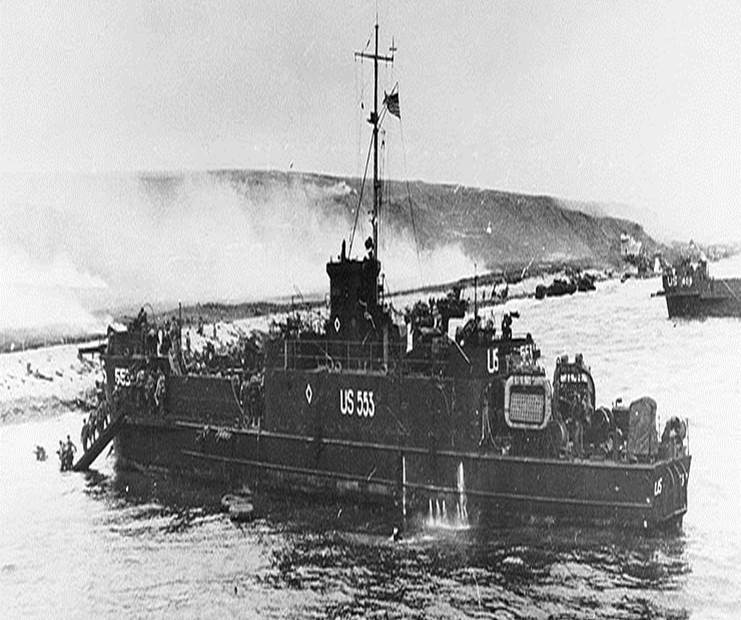
Figure 9. LCI(L) – Landing Craft, Infantry (Large), the type of craft on which Capa made his departure from Easy Red. With a capacity of about 186 troops, it was the largest beaching craft used at Omaha on D-Day. The LCI(L)-553 is shown beaching on Easy Red west of the ruins. It discharged its troops without incident. Unfortunately, it was stuck on the beach, and repeated efforts to free it failed. The crew eventually abandoned ship. It was only later that German fire was able to finally hit the abandoned ship and start a fatal fire.
[Note: In the course of researching this topic, I came another site whose publisher had developed a parallel thesis concerning Capa’s landing point. While our treatments differ in many respects, Pieter Jutte’s conclusions and insights (in regard to several aspects of the D-Day landings, not just Capa’s photos) are compelling and well worth studying. The interested reader can find the relevant work at his site, which has the English title D-Day Battlefield Normandy. Unfortunately, the pertinent sections appear there in Dutch only. — C. H.]
[Note, September 28, 2015: In response to this post, Pieter Jutte revised his analysis of Capa’s Omaha Beach images, and also translated his several Capa pages into English for the convenience of international readers. — Ed.]
Picture credits:
- Figure 7: Omaha Beachhead (6 June – 13 June 1944), American Forces in Action Series (U.S. War Dept., Historical Division, 1994).
- Figure 8: U. S. Army Air Force, aerial views of Easy Red, June 30, 1943, composite by Thierry Nicolle.
- Figure 9: NavSource Online: Amphibious Photo Archive.
(Part 1 I 2)
•
[Editor’s Note: Herrick’s conclusion regarding the time of Capa’s arrival at Easy Red differs from that of J. Ross Baughman, and from mine. But it does not undermine in any way our most important discoveries: that Capa arrived with the second wave, not the first; spent only 15-30 minutes at most photographing on Omaha Beach; and made only the ten surviving 35mm negatives while there. Indeed, it provides further support for all those interpretations of the evidence.
The main difference between Herrick’s analysis and ours is this: his reading has Capa arriving at Omaha Beach much later than we do, at 0820, thus boarding LCI(L)-94 shortly before its departure from the beach at 0837, rather than almost an hour earlier. That would contradict Capa’s own account of boarding LCI(L)-94 immediately after its passengers disembarked. It would also leave him with hardly any time at all to regain his composure and consider returning to the beach so as to complete his assignment — time that Baughman and I believe he had.
Beyond that, Herrick’s timeline confounds even further than does Baughman’s and mine the current widespread assumption that “The Face in the Surf” in Capa’s best-known D-Day photo belongs to Private Huston Riley, who claims he encountered “a press photographer” (presumably Capa) whom he saw run to a landing craft. Both of those conclusions rely on a tenuous conjunction between a passage in Capa’s heavily fictionalized 1947 memoir, Slightly Out of Focus, and Riley’s recollection, first articulated for the record six decades after the event and thus possibly unreliable.
This certainly allows for variations in the timeline, especially given the fact that the military records themselves, most likely filled in not as events occurred but hours later, necessarily contain some inaccuracies. However, unquestionably, Riley arrived much earlier than the 0720 that Baughman and I consider Capa’s moment of landing, and even longer before Herrick puts him there; according to Lowell Getz’s detailed account, Riley “came ashore with Section 2, Fox Company, 2nd Battalion, 16th Regiment, 1st Infantry Division. Fox Company landed 10 minutes behind schedule, at 0640 hours.”
Because I find Herrick’s narrative closely reasoned, consistent with the evidence, and no less plausible than Baughman’s effort and my own, I’m publishing it here. — A. D. C.]
(Part 1 I 2)
Text copyright © 2015 by Charles Herrick. Illustrations © Charles Herrick 2015 as noted. All rights reserved.
•
(For an index of links to all posts in this series, click here.)
•
 Charles Herrick joined the U.S. Army in 1970 and graduated from the U.S. Military Academy at West Point in 1974. Commissioned in the Infantry, he earned the Ranger tab and Master Parachutist’s wings. He served in a variety of positions from company grade officer to the Pentagon. He earned the Combat Infantryman’s badge while assigned as the Operations Officer of the 193rd Infantry Brigade in Panama in 1989, and later graduated from the U.S. Army War College.
Charles Herrick joined the U.S. Army in 1970 and graduated from the U.S. Military Academy at West Point in 1974. Commissioned in the Infantry, he earned the Ranger tab and Master Parachutist’s wings. He served in a variety of positions from company grade officer to the Pentagon. He earned the Combat Infantryman’s badge while assigned as the Operations Officer of the 193rd Infantry Brigade in Panama in 1989, and later graduated from the U.S. Army War College.
Since retiring from the Army in 1996, Herrick has continued to work on defense issues as a contractor in East Asia, Latin America, the Balkans, Africa and Central Asia. He holds an MBA from the University of California at Los Angeles. He lives in California with his wife, where he pursues his passion for military history. To contact Charles Herrick, click here.


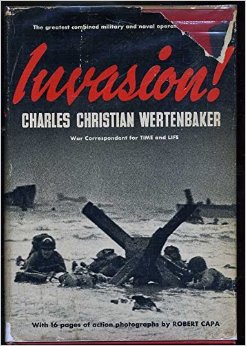
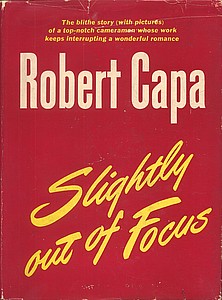
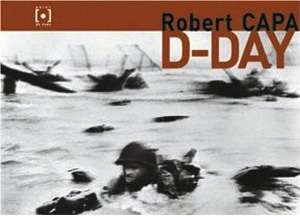




I’ve been following the Capa deconstruction on your blog since it began and remain fascinated with both the story and your diligence in investigating it. I’m equally fascinated by how strongly people who have bought the Capa story for decades desperately want to hold on to their mythology, truth be damned. Thanks for standing up for truth over fiction.
Great reading, all the way. Thanks to Charles Herrick, who contacted me a while ago, I have made the pages on Capa his work on Omaha more extensive, and is now an article in process. Further more, I translated it for the international reader. Keep in mind, English is not my native lingo, so some words may be wrong chosen. You may check it here http://www.strijdbewijs.nl/robert/capa1.htm
Thanks for translating your Capa-related pages into English. I have added a note to this post indicating that you have done so.